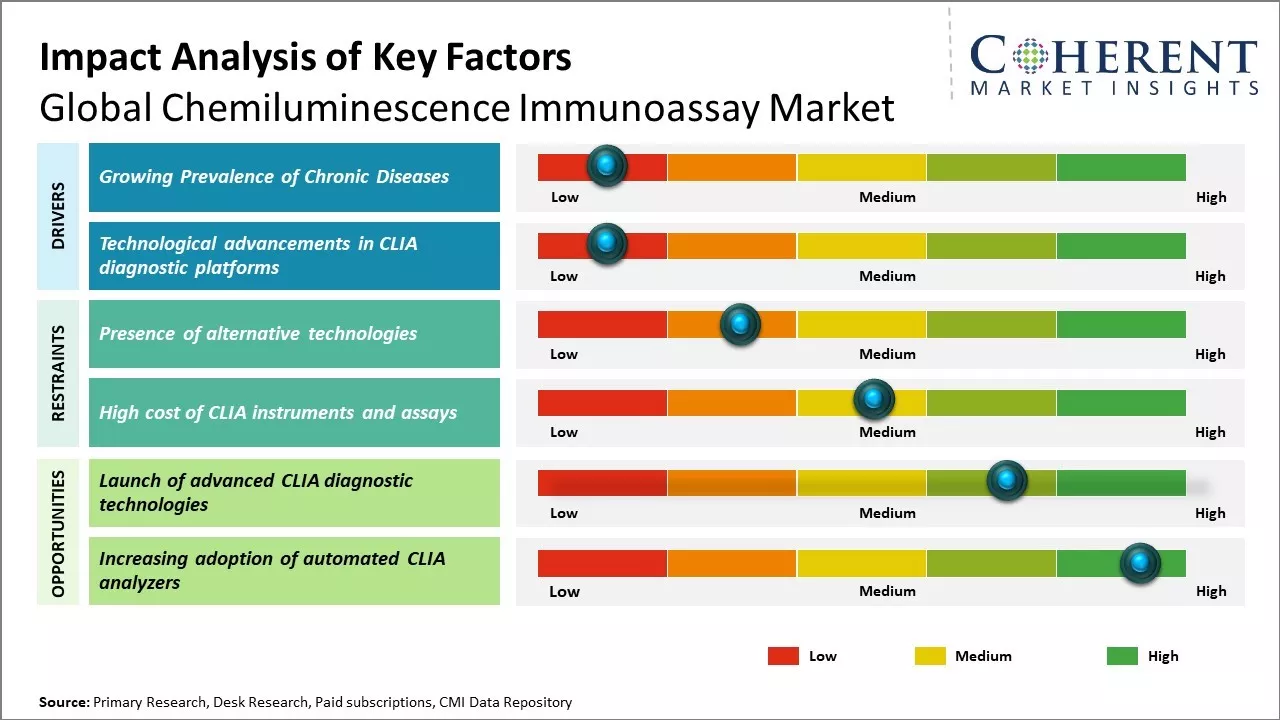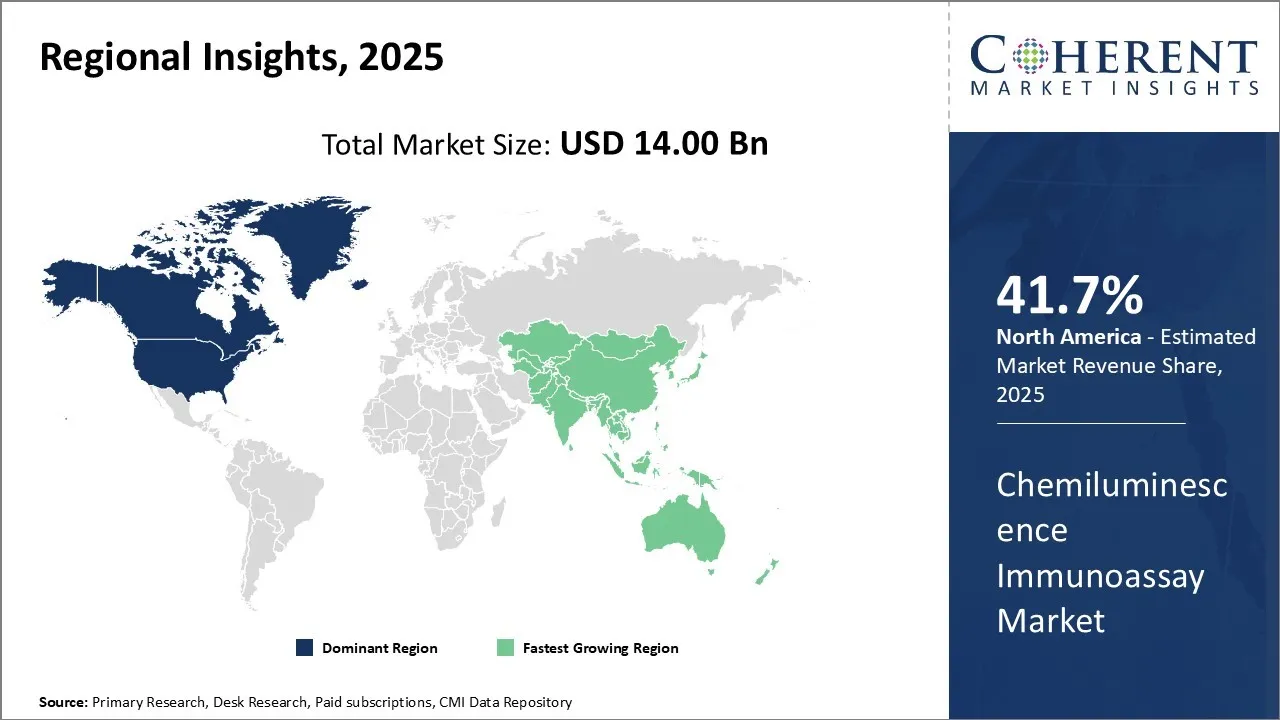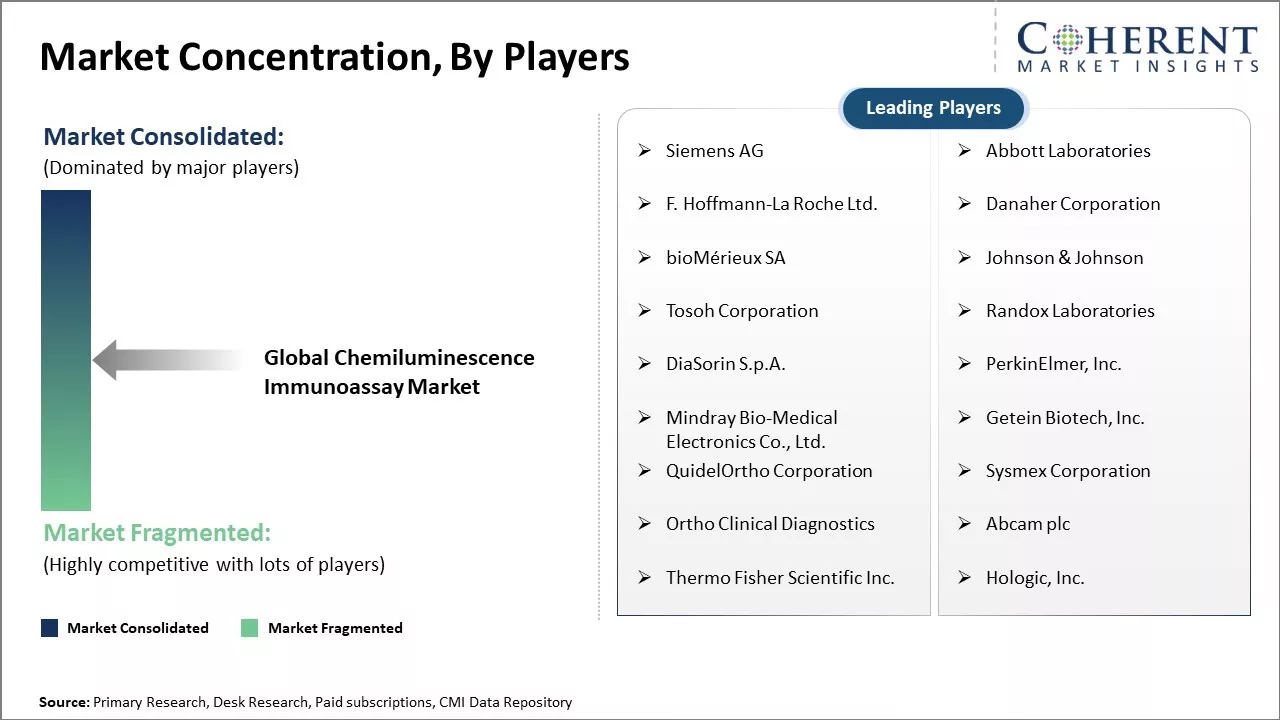Global chemiluminescence immunoassay market is estimated to be valued at USD 14.00 Bn in 2025 and is expected to reach USD 22.21 Bn by 2032, exhibiting a compound annual growth rate (CAGR) of 6.8% from 2025 to 2032.

To learn more about this report, Download Free Sample
The global chemiluminescence immunoassay market growth includes increasing disease prevalence, rising healthcare expenditure across developing nations, growing demand for clinical diagnostics to detect chronic diseases such as cancer, cardiovascular diseases, and infectious diseases. Furthermore, advancement in chemiluminescence immunoassay instruments, tools and reagents allowing fast and reliable detection of a wide range of analytes from small molecules to larger proteins through high sensitivity. These factors are contributing in increase of adoption rate especially in hospitals and diagnostic laboratories, thus, driving the chemiluminescence immunoassay market growth.
|
Current Events |
Description and its Impacts |
|
Regulatory Policy Shifts in Key Markets |
|
|
Geopolitical Supply Chain Pressures |
|
Uncover macros and micros vetted on 75+ parameters: Get instant access to report
Chemiluminescence immunoassay (CLIA) has become a key tool in clinical diagnostics, valued for its sensitivity, specificity, and relatively fast turnaround. However, end users such as laboratory technicians, clinical scientists, and healthcare providers have shared important feedback highlighting areas where current CLIA technology can improve.
In terms of Product Type, Reagents segment is estimated to contribute the highest market share of 58.6% in 2025, owing to its wide range of applications across various disease testing. Reagents play a crucial role in chemiluminescence immunoassay as this help produce light during the biochemical reactions between an antigen and its specific antibody. The high accuracy and sensitivity offered by reagents in detecting various biomarkers has made them invaluable for diagnosing several diseases. Their ability to produce measurable light signals proportional to the concentration of analytes in a sample allows for precise quantification of biomarkers. This has significantly improved disease diagnosis and management. Reagents are indispensable for chemiluminescent assays used in therapeutic drug monitoring to quantify drug concentrations in patient samples and determine optimal dosages. This is further accelerating the chemiluminescence immunoassay market demand.
In December 2024, Roche, a biotechnology company, announced its CR mark approval for its cobas® Mass Spec solution including the cobas® i 601analyser and the first Ionify® reagent pack of four assays for steroid hormones. The cobas mass Spec solution offers more than 60 analytes for testing of steroid hormones, vitamin D metabolites, immunosuppressant drugs (ISD), therapeutic drug monitoring (TDM) and drug of abuse testing (DAT).
In terms of application, therapeutic drug monitoring segment is estimated to contribute the highest market share of 30.62% in 2025, owing to pressing need for optimizing pharmacotherapy. Therapeutic Drug Monitoring (TDM) utilizes assays such as chemiluminescence immunoassays to quantify drug concentrations in patients' blood and tissues. This assists clinicians in individualizing drug dosing regimens based on patients' pharmacokinetic characteristics and responses. TDM is crucial considering the factors including age, organ function, co-medications, and genetic variability influence patients' abilities to metabolize and eliminate drugs from their bodies. Measuring blood drug and metabolite levels helps physicians assess a patient's compliance, verify that the working levels are within the therapeutic window, detect toxic concentrations earlier, and prevent clinical failures or relapses. This is further contributing to the Chemiluminescence Immunoassay market share.
For Instance, in September 2024, the World Health Expo Insights published an article evolving the role of clinical pharmacist in enhancing Therapeutic Drug Monitoring (TDM) practices. As it is a critical component in personalized medicine involving measuring drug concentration in patients to optimize dosage regimen. The clinical pharmacists play a role in utilizing their expertise to interpret pharmacokinetic data and adjust therapies accordingly. Dr. Nagy focuses on pharmacist involvement that ensure more precise medication management, reducing adverse effects and improving therapeutic outcomes.
In terms of sample type, blood segment is estimated to contribute the highest market share of 40.5% in 2025, owing to its universal suitability as a diagnostic sample across disease areas. Chemiluminescence immunoassays utilizing blood-based tumor markers which plays a pivotal role in cancer screening, diagnosis, prognosis assessment, and surveillance following therapy. These assays offer high sensitivity for detecting extracellular circulating tumor biomarkers such as CEA, CA 15-3, CA 19-9 and PSA, sometimes even before anatomical changes occur. Serial marker monitoring aids in detecting recurrence earlier or treatment resistance. Multiplex assays improve efficiency by simultaneously quantifying several relevant markers from one blood sample. On-invasive blood collection, fast turnaround times, high throughput processing abilities of modern immunoassay systems, and widespread familiarity with blood sample types have made chemiluminescent assays standard-of-care in oncology laboratories globally.
In April 2025, researchers from Weil Cornell Medicine and the New York Genome Center developed an innovative blood test method that improves the accuracy and sensitivity of cancer detection. This advancement utilizes whole-genome sequencing combines with error-correction technique to identify minute concentration of circulating tumor DNA (ctDNA) in blood sample.
In terms of end user, the clinical laboratories segment is expected to dominate the market with the highest shares in 2025, due to its high volume of testing and outsourcing for hospitals. The principle of chemiluminescence is used in clinical laboratories to utilizes certain chemicals reactions to produce light which will measure and interpret the concentration of analyte. Some of the commonly used techniques used in clinical laboratories to identify infectious disease include microscopy, immunological tests, culture and nucleic acid-based identification methods. These techniques help in detecting, isolating and identifying infectious agents in clinical specimens, allowing for diagnosis and appropriate treatment.
In January 2025, Bangalore medical College and Research Institute (BMCRI) hosted the Indian Council of Medical Research’s (ICMR) first Infectious Disease Research and Diagnostic Laboratory (IRDL). This in-stare IRDL will help the state’s health institutions in testing infectious disease sample quickly, especially during outbreak investigation, enable in-depth research, improve medical institution capability and enhance disease surveillance activities.

To learn more about this report, Download Free Sample
North America dominates the global chemiluminescence immunoassay market with an estimated market share of 41.7% in 2025, due to the advanced healthcare infrastructure and rising adoption of advanced diagnostic technologies across major countries like the U.S. Several leading global players have their headquarters located in the region and have established widespread sales and distribution networks. According to the NetSuite, US healthcare expenditures will approach USD 5 trillion in 2025, accounting for more than 18% of the country’s gross domestic product. Along with that, the presence of major pharmaceutical and life sciences companies has also augmented the regional market growth. According to the IBISWorld, there are over 45,000 life science companies in the U.S., as of early 2024, and over 5,000 pharmaceutical companies and around 2,435 biotechnology companies which is expected to increase to 2,533 in 2025. Favorable regulatory environment and healthcare reimbursement policies have facilitated wider uptake of chemiluminescence immunoassay systems in the region.
Asia Pacific is witnessing the fastest growth and is expected to grow further during the forecast period. China, in particular, is spearheading the market expansion owing to continual modernization of healthcare facilities and increasing healthcare expenditures. The rapidly growing geriatric population, coupled with rising prevalence of chronic and infectious diseases have boosted demand for diagnostic testing. Some of the commonly observed chronic disease in Aisa are cardiovascular disease with approximately 348.9 million cases in 2025, which is expected to rise to 729.5 million by 2050, 57.2 million individuals in India suffering from Diabetes and chronic kidney disease with the highest prevalence rate in Aisa. There is a current expanding situation of COVID-19 in May 2025, the Southeast Asian countries such as India, Singapore, Thailand and China are experiencing a resurgence of cases with 257 cases reported in India, weekly increases in cases from 11,000 to 14,000 in Singapore and 71,000 cases in Thailand since January 2025. Expansion of private healthcare sector and increasing medical tourism are also favoring Chemiluminescence Immunoassay market growth across the region.
The United States is the leading country for chemiluminescence immunoassay market. The expansion of the market is observed due to the advanced healthcare infrastructure and widespread adoption of CLIA technologies. Along with that, the United States has the highest prevalence of chronic disease which considered the healthcare cost of around $4.5 trillion annual healthcare spending. 6 in 10 American have at least one chronic disease and 4 in 10 have more than two.
In July 2024, Fujirebio, a subsidiary of H.U. Group Holdings Inc., launched its Lumipulse® G GFAP assay, a fully automated, research-use-only (RUO) test in United States. It is designed to quantitative measurement of glial fibrillary acidic protein (GFAP) in human plasma and serum. This chemiluminescent enzyme immunoassay (CLEIA) delivers results in just 35 minutes and is compatible with the LUMIPULSE® G immunoassay systems.
China market for chemiluminescence immunoassay is characterized by a modernization of healthcare facilitates, increasing in healthcare expenditure and rising prevalence of chronic and infectious disease. China is increasing it focus towards access, quality and efficiency. The modernization is supported by the government’s “Healthy China 2030” plan. Along with that, the expanding health insurance coverage, investing in infrastructure and leveraging digital technologies such as artificial intelligence (AI) ad telemedicine is contributing to the growth of the market. According to the World Bank’s joint report with the Chinese government found that, without reform, health spending would increase to USD 2.5 trillion in 2035.
Germany chemiluminescence immunoassay market is expected to continue its growth trajectory, supported by the technological advancements in automation, rising demand for diagnostics, reimbursements policies and growing healthcare expenditure. Germany claims to be the third largest medical technology market in the world after the United States and Japan. The medical device market in Germany accounts to roughly USD 42 billion annually, or 25% of the European market.

To learn more about this report, Download Free Sample
| Report Coverage | Details | ||
|---|---|---|---|
| Base Year: | 2024 | Market Size in 2025: | USD 14.00 Bn |
| Historical Data for: | 2020 To 2024 | Forecast Period: | 2025 To 2032 |
| Forecast Period 2025 to 2032 CAGR: | 6.8% | 2032 Value Projection: | USD 22.21 Bn |
| Geographies covered: |
|
||
| Segments covered: |
|
||
| Companies covered: |
Siemens AG, Abbott Laboratories, F. Hoffmann-La Roche Ltd., Danaher Corporation, bioMérieux SA, Johnson & Johnson, Tosoh Corporation, Randox Laboratories, DiaSorin S.p.A., PerkinElmer, Inc., Mindray Bio-Medical Electronics Co., Ltd., Getein Biotech, Inc., QuidelOrtho Corporation, Sysmex Corporation, Ortho Clinical Diagnostics, Abcam plc, Thermo Fisher Scientific Inc., Hologic, Inc. |
||
| Growth Drivers: |
|
||
| Restraints & Challenges: |
|
||
Uncover macros and micros vetted on 75+ parameters: Get instant access to report
Rising incidence of chronic and infectious diseases across the globe has boosted demand for chemiluminescence immunoassay testing. According to various estimates by the healthcare experts and researchers, the chronic diseases have now overtaken infectious illnesses as the major cause of mortality worldwide. Approximately 129 million individuals in the US suffer from at least one major chronic disease—such as heart disease, cancer, diabetes, obesity, or hypertension—according to the US Department of Health and Human Services. Lifestyle changes such as unhealthy eating habits, lack of physical activity, rising stress levels and smoking have majorly contributed to staggering increase in conditions like cancer, diabetes, cardiovascular diseases and respiratory illnesses. As people are now living longer with these chronic illnesses, there has been rising need for frequent medical monitoring and screening tests. Chemiluminescence immunoassays provide accurate, precise and timely diagnosis of various chronic conditions. These assays are extensively used in hospitals and diagnostic labs for detecting cardiac marker enzymes to aid in the diagnosis of heart attacks.
Technological advancements are drastically transforming the chemiluminescence immunoassay (CLIA) diagnostic platforms. Several innovative CLIA analyzers have widened the scope of CLIA testing. The new generation fully automated, high throughput CLIA analyzers offer enhanced sensitivity, specificity, faster turn-around-time and expanded assay menus as compared to conventional immunoassay technologies. For instance, as per World Health Organization in 2022, the Liaison range of CLIA analyzers by DiaSorin can perform a wide variety of routine and specialty tests including therapeutic drug monitoring, endocrinology, oncology, infectious diseases from a small patient sample volume in a single analytical run. (Furthermore, software and digital innovations are revolutionizing the CLIA diagnostic platforms. Many new systems are integrated with artificial intelligence (AI) and machine learning capabilities. This allows automated interpretation of test results, flagging of outliers, improved quality control, customized report generations and remote diagnostics. Cloud connectivity in some systems ensures real-time data access for clinicians from different locations. For instance, the Affinity total laboratory automation solution from Siemens Healthineers uses AI to automate repetitive tasks, standardized workflows and predictive maintenance to maximize efficiency.
The introduction of advanced chemiluminescence immunoassay (CLIA) diagnostic technologies provide a great opportunity to drive global chemiluminescence immunoassay market forecast growth. CLIA techniques have significantly evolved in recent years to offer higher sensitivity, wider detection range, faster turn-around times and improved automation. Some of the key advanced CLIA technologies that are gaining traction include enhanced chemiluminescence immunoassay (ECLIA), nano-immune technology and microfluidic immunoassay systems. This is further accelerating the chemiluminescence immunoassay market demand.
*Definition: Global Chemiluminescence Immunoassay Market involves the use of chemiluminescence detection to measure the presence and concentrations of various substances in biological samples like blood, urine, and tissue. Chemiluminescence immunoassays use antibodies attached to luminescent molecules to detect target antigens or antibodies in samples. This market covers sales of chemiluminescence immunoassay instruments, consumables, and reagents for clinical diagnostics and research applications globally.
Share
Share
About Author
Komal Dighe is a Management Consultant with over 8 years of experience in market research and consulting. She excels in managing and delivering high-quality insights and solutions in Health-tech Consulting reports. Her expertise encompasses conducting both primary and secondary research, effectively addressing client requirements, and excelling in market estimation and forecast. Her comprehensive approach ensures that clients receive thorough and accurate analyses, enabling them to make informed decisions and capitalize on market opportunities.
Missing comfort of reading report in your local language? Find your preferred language :
Transform your Strategy with Exclusive Trending Reports :
Frequently Asked Questions
Joining thousands of companies around the world committed to making the Excellent Business Solutions.
View All Our Clients